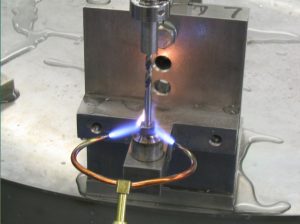 Use the brazing process to boost your metalworking applications
Use the brazing process to boost your metalworking applications
August 29, 2014 REDWIRE is news you can use from leading suppliers. Powered by FRASERS.
Posted by Fusion Inc
Fusion, Inc. is a global leader in brazing and soldering innovation. Headquartered outside Cleveland in Willoughby, OH U... Read more
Subscribe
Free REDWIRE e-newsletter

What do pipes, bicycle kickstands and the base of a light bulb all have in common? Each of these mechanisms is manufactured using the brazing process.
Brazing is a metalworking process designed to join two dissimilar, non-ferrous alloys such as copper, silver or zinc, into one. Melting temperatures of 450°C (840°F) or higher is achieved by varying sources of heat, including torches, furnaces, infrared heat or through the simple baked goodness an oven provides.
Proper prep is vital to ensure a textbook brazing application. Best brazing practice includes a good scrub down of the base metals to be brazed. Metal surfaces need to be clean as a whistle from oil, grease or rust before immediately priming them with flux.
Flux is a protective compound shielding metal surfaces from oxides, which is the result of a chemical reaction between hot metal and oxygen.
Oxides on metal surfaces is a brazing no-go: the more oxides present on surfaces, the less effective braze filler is to make contact. A dollop of flux paste goes a long way to guarantee an even distribution of the magic ingredient called braze.
Braze is a metallic filler that is essentially the “glue” holding the two metals together.
The braze is then blazed, that is, it is heated at high temperatures into a molten-type substance and then applied between the metal alloys to bridge the gap. The brazed joint becomes a sandwich of various layers, metallurgically bonded to one another. After the cooling process, the once separate base metals transform into a superbly strong and sealed joint.
While the welding and brazing process both involve melting metals together into a unified joint, brazing is completed over the entire surface of the base metals (fortified with braze) whereas welding joins two pieces of metal only around the edges.
Because of this difference, brazing has the upper hand in producing a significantly tougher and smoother joint at a fraction of the cost.
Beyond the cost-effectiveness in the amount of braze used, the brazing process offers resilient airtight and watertight sealing, delivering a near-invincible joined fabrication.
Learn more and braze more with Fusion Inc. Contact us today by checking out our website located above.
Share
Posted by Fusion Inc
Fusion, Inc. is a global leader in brazing and soldering innovation. Headquartered outside Cleveland in Willoughby, OH U... Read more